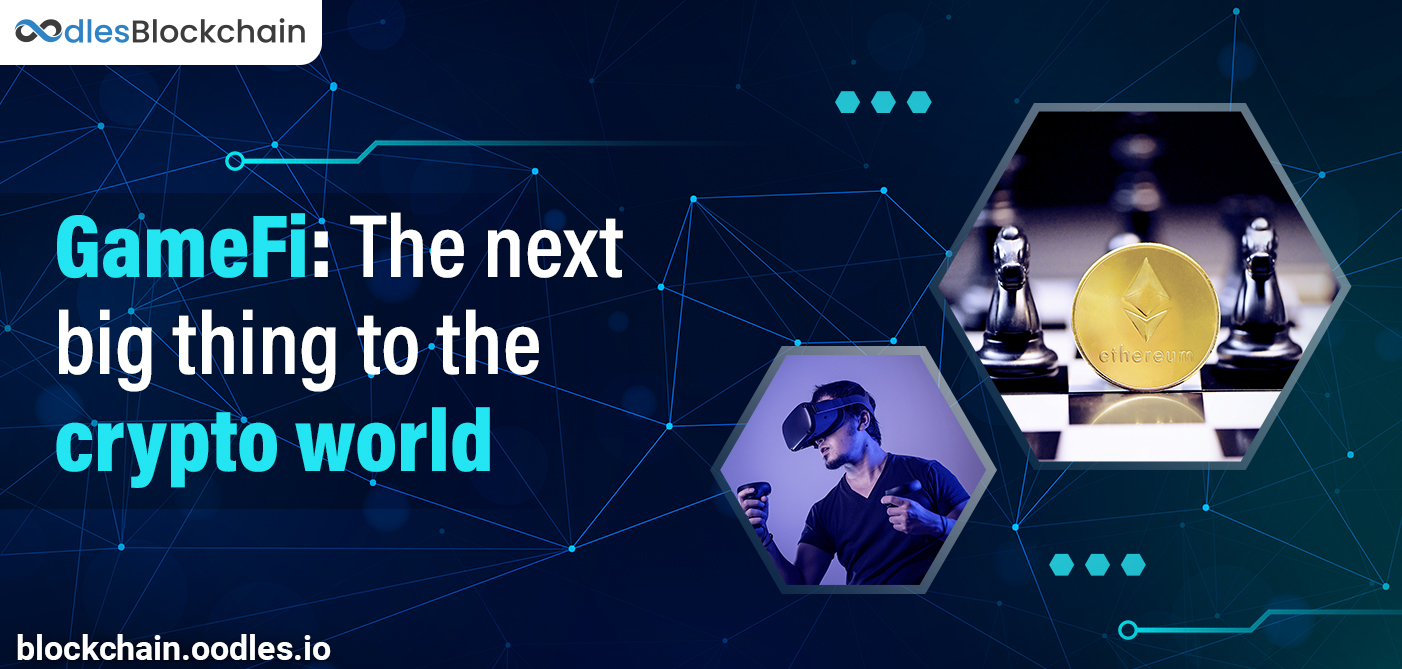-
Imagine living in a society where even playing video games can enable you to earn money. Money that helps with bills and keeps food on the table, not bogus in-game currency. Imagine purchasing and selling assets you won in a game, including the characters, clothes, and weaponry, in the real world. Essentially, this is what GameFi promises. It is among the trendiest Web3 industry concepts enabled by blockchain development services.
Understanding GameFI
The phrase GameFi, which combines the terms game and finance, describes blockchain games with monetary incentives for players. Players typically gain in-game rewards by performing tasks and engaging in different battles of a game. Advancing to different game levels is another way to earn incentives such as crypto tokens, virtual land, and other Non-Fungible Tokens (NFTs). When compared to conventional video games, play-to-earn video games allows buying and selling in-game assets. Additionally, you can move in-game assets outside of the virtual world. Also, Read | Play-to-Earn NFT Games | Driving the GameFI Revolution
How it Works
NFTs, or digital tokens, represent all the products in games. They serve as proof of owning rare intangible assets. Consider land plots, avatars, outfits, tools, gold bars, and other items. Players have different choices when it comes to using these assets. One way is to trade these assets with others in online marketplaces for various NFTs. Another alternative is to sell them in exchange for cryptocurrencies. Users can enhance their earning potential depending on the game they are playing. Leveling up and upgrading the characters is an obvious option. Moreover, building monetized constructions on their land that other players can pay to use or participate in tournaments are other alternatives. The public blockchain maintains all the transaction data of NFTs and cryptocurrency to track the possessions of each player. A vast computer network supports this kind of distributed, digital record-keeping technology. The following advantages come from using this technology in gaming:
- Players can readily substantiate their ownership of in-game items.
- This technology doesn't have any point of failure, enabling gamers to keep track of their possessions. Gamers don't have to worry even if the underlying gaming firm encounters technological difficulties.
- You cannot copy, take away or destroy the play-earned items.
- You cannot transfer and receive cryptocurrencies designed for gaming without using a third party for custody, clearing, or settlement.
Some games also include DeFi elements such as staking. These elements enable players to lock away tokens for annual interest. Moreover, players can save to purchase other in-game items or unlock new content for a few rewards. Also, Read | Initial Game Offering (IGO) Launchpad Development
Play-to-Earn Gaming (P2E)
Conventionally, video games use a pay-to-play paradigm. However, GameFi employs a play-to-earn (P2E) concept. Players must pay money up ahead to play pay-to-play games like Call of Duty. P2E makes gaming more profitable and engaging by allowing gamers to earn incentives while participating. Also, Read | How to Develop Play-to-Earn Game in Sandbox
Benefits of GameFi
Now, the next logical point to bring up is the advantages of projects on a GameFi list. You can find the finest DeFi, blockchain, NFTs, and gaming in this new realm of online gaming. What are GameFi projects' value-added advantages, and how may they change the video game industry?
Rewards for Gaming
With the introduction of GameFi, the play-to-earn gaming model has significantly impacted the gaming industry. New ideas reject the old games' economic structure, which heavily relied on in-app purchases and advertising. Players were also not permitted to use their in-game items outside the game. On the other hand, blockchain-based play-to-earn games enable the exchange of in-game currency for in-game tokens and products. Players can utilize their in-game items outside of the game as a result. For instance, trading in-game tokens on secondary markets gives players access to more significant rewards.
Limited Participation Cost
Minimal costs are the next significant value benefit related to GameFI projects. You can download and play the majority of the games in the realm of gaming finance. Compared to typical games, play-to-earn games have the advantage of being more accessible.
The curve of Easy Learning
Many consumers are wary of playing GameFi games because they are dubious of the new "play to earn" business model. Though, players don't need to worry about following complicated instructions or steps to play these games. On the other hand, one of the most appealing aspects of play-to-earn games is their straightforward mechanics. As a result, there are very few obstacles to playing games that pay real money.
Own the Gameplay
The promise of total ownership control over your assets is the best value advantage in the GameFi NFT world. The blockchain networks will store all the information about your in-game assets and NFTs through gaming finance projects. You won't lose all your possessions even if the game shuts down. All the resources that players own in the game are entirely in their hands. They are free to use them in any way they see fit. Also, Read | Play-to-Earn NFT Games | Fundamentals and Development Essentials
What's Next
GameFi influences significant changes in the gaming and blockchain industries. It provides the user control we desperately need as we advance with Web3. Its application of DeFi ideas also generates opportunities for consumers to make money while enjoying playing games. However, GameFi's ability to uphold decentralization will be a key to its success. It can alter how we view gaming if it adheres to its guiding principles of user choice, influence, and rewards. Connect with our skilled gaming and blockchain developers for more information about GameFI.

Our Offices
INDIA
Emaar Digital Greens, Sector 61,
Gurugram, Haryana
122011.
Welldone Tech Park,
Sector 48, Sohna road,
Gurugram, Haryana
122018.















